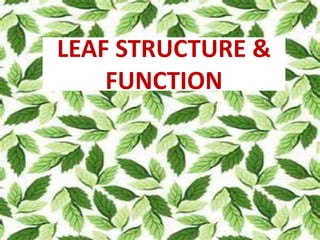
Leaf structure
- 1. LEAF STRUCTURE & FUNCTION
- 2. Role of leaves: Trap light for photosynthesis Exchange gases
- 3. Leaves do not shade each other To trap as much light as possible
- 4. External structure of a leaf margin petiole [leaf stalk] midrib vein lamina [blade]
- 5. Monocot & Dicot leaves Long & slender leaf Parallel veins Broad leaf Branching veins
- 6. Veins contain xylem & phloem
- 7. Xylem & Phloem transport materials in plants Xylem transports: Water + mineral salts Phloem transports: Food [sucrose, amino acids]
- 8. Internal structure of a leaf margin guard cells Stoma [plural: stomata] palisade layer spongy layer xylem phloem
- 9. Internal structure of a leaf
- 10. Function of the waxy cuticle: prevents loss of water
- 11. Why are epidermal cells transparent? to allow a lot of light to pas through
- 12. Vertical section through a leaf 8. Guard cell 7. stoma 1. Waxy cuticle 2. Upper epidermis 3. Palisade mesophyll cell 4. Air space 5. Spongy mesophyll cell 6. Lower epidermis
- 13. QUESTION: [MAY, 2010] Give a biological explanation for the following statement: Leaves are well adapted for efficient diffusion of carbon dioxide. (4)
- 14. QUESTION: [MAY, 2010] The flattened shape of leaves increases the surface area for diffusion. 1 mark Most plants have thin leaves – this means that the distance for the carbon dioxide to diffuse from the outside air to the photosynthesising cells is kept as short as possible. 2 marks The many air spaces inside the leaf allow carbon dioxide to come into contact with lots of cells – this provides lots of surface area for diffusion. 1 mark Stomata allow carbon dioxide into the leaf. 1mark
- 15. Why is the upper leaf surface darker green than the lower surface? More chloroplasts in palisade layer than in spongy layer.
- 16. Vascular tissue is present throughout the plant
- 17. What is the function of the: Stoma: allows exchange of gases Guard cells: to adjust the opening and closing of the stoma
- 18. When are stomata open and when are they closed? DAY NIGHT
- 19. open their stomata during the NIGHT
- 20. How do stomata open during the day? potassium ions enter the guard cells & water follows.
- 21. Where are stomata located in:
- 22. Stomata are located: mostly on the lower leaf surface each leaf surface has an equal number of stomata
- 23. NO stomata in submerged leaves Stomata only on upper leaf surface in floating leaves
- 24. Why are stomata located like this? Lower leaf surface is more protected from the sun Each leaf surface is equally exposed to the sun
- 25. Stomata are useless: they are not in contact with air Stomata allow gas exchange with the air
- 26. Differences between guard cells and the surrounding epidermal cells. Guard cells Epidermal cells 1) have chloroplasts Chloroplasts absent 2) are bean-shaped Cuboidal in shape 3) cell walls are not evenly thick Cell walls evenly thick
- 27. Structure of a dicot plant
- 28. Structure of a dicot plant Internode Node Main/tap root Veins Terminal/apical bud Leaf Petiole Lateral/axillary bud Stem Lateral roots